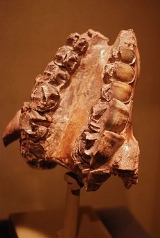
Homalodotherium
Encyclopedia
Homalodotherium is an extinct genus of the order Notoungulata
, an extinct group of hoofed mammals native to South America.
Homalodotherium was about 2 metres (6.6 ft) in body length, and had long forelimbs with claw
s instead of hooves. It walked on the soles of its hind feet and the toes of its front feet, which would have made the animal higher at the shoulder than at the hips when it walked on all fours. It was probably at least partially bipedal, being able to pull down tree branches with its arms while rearing up on its hind legs. Various other prehistoric and living creatures have also developed this feeding style; examples are the chalicothere
s, ground sloth
s, the giant panda
and, possibly, the therizinosaur
dinosaur
s.
Notoungulata
Notoungulata is an extinct order of hoofed, sometimes heavy bodied mammalian ungulates which inhabited South America during the Paleocene to Pleistocene, living from approximately 57 Ma to 11,000 years ago.-Taxonomy:...
, an extinct group of hoofed mammals native to South America.
Homalodotherium was about 2 metres (6.6 ft) in body length, and had long forelimbs with claw
Claw
A claw is a curved, pointed appendage, found at the end of a toe or finger in most mammals, birds, and some reptiles. However, the word "claw" is also often used in reference to an invertebrate. Somewhat similar fine hooked structures are found in arthropods such as beetles and spiders, at the end...
s instead of hooves. It walked on the soles of its hind feet and the toes of its front feet, which would have made the animal higher at the shoulder than at the hips when it walked on all fours. It was probably at least partially bipedal, being able to pull down tree branches with its arms while rearing up on its hind legs. Various other prehistoric and living creatures have also developed this feeding style; examples are the chalicothere
Chalicothere
Chalicotheres were a group of herbivorous, odd-toed ungulate mammals spread throughout North America, Europe, Asia, and Africa during the Early Eocene to Early Pleistocene subepochs living from 55.8 mya—781,000 years ago, existing for approximately .They evolved around 40 million years ago from...
s, ground sloth
Ground sloth
Ground sloths are a diverse group of extinct sloths, in the mammalian superorder Xenarthra. Their most recent survivors lived in the Antilles, where it has been proposed they may have survived until 1550 CE; however, the youngest AMS radiocarbon date reported is 4190 BP, calibrated to c. 4700 BP...
s, the giant panda
Giant Panda
The giant panda, or panda is a bear native to central-western and south western China. It is easily recognized by its large, distinctive black patches around the eyes, over the ears, and across its round body. Though it belongs to the order Carnivora, the panda's diet is 99% bamboo...
and, possibly, the therizinosaur
Therizinosaur
Therizinosaurs are theropod dinosaurs belonging to the clade Therizinosauria. Therizinosaur fossils have been found in Early through Late Cretaceous deposits in Mongolia, the People's Republic of China and Western North America...
dinosaur
Dinosaur
Dinosaurs are a diverse group of animals of the clade and superorder Dinosauria. They were the dominant terrestrial vertebrates for over 160 million years, from the late Triassic period until the end of the Cretaceous , when the Cretaceous–Paleogene extinction event led to the extinction of...
s.

